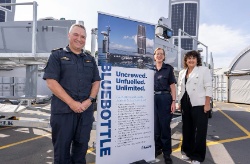Regional Council Celebrates The Power Of Partnerships At Rangiuru Business Park Milestone

Representatives from Bay of Plenty Regional Council were proud attendees at the official opening of the Rangiuru Business Park Interchange on Friday [SUBS: February 14], where they were able to see two decades of support for the Business Park realised.
The significant moment highlighted the Regional Council’s pivotal role in enabling the project, through its strategic financial support and collaboration with other agencies.
Bay of Plenty Regional Council Chair Doug Leeder says the Regional Council has been a key supporter of the Rangiuru Business Park throughout a process that has been two decades in the making.
“The key feature that has ensured this project’s success and ability to get to this point has been how we have worked with Quayside Holdings, Western Bay of Plenty District Council and other SmartGrowth partners, along with central government and mana whenua.”
Quayside is the investment arm of Regional Council, with a focus on delivering sustainable long-term returns that, in turn, provide prosperity to the region. The purpose of the Rangiuru Business Park is to facilitate and support economic development in the Western Bay of Plenty.
In 2004, the newly established SmartGrowth strategy outlined the projected growth in the Bay of Plenty and the infrastructure requirements that would need to be put in place to accommodate this. One of the key drivers was the growth of the Port of Tauranga and the need for new commercial and industrial land to the east of Tauranga, as well as the employment growth expected from a rapidly expanding population.
Quayside finalised the strategic land purchase in 2005 and worked with Western Bay of Plenty District Council to achieve private plan changes, consents, and to develop and fund infrastructure requirements.
Chair Leeder says the Regional Council’s strong balance sheet and ability to secure low-cost financing from the Local Government Funding Agency was crucial to the delivery of the project and helping unlock its economic development potential.
He says it was this financial strategy that saved Quayside several percentage points in interest, ensuring the project’s financial viability and accelerating progress without directly burdening ratepayers.
“Rangiuru is different from most of Quayside’s activities, as it is not primarily focused on financial return, but on economic growth, jobs, and regional benefits.
“Developments of this scale are not cheap, and the Regional Council has supported Quayside in several ways to deliver this project and help unlock its economic development potential.”
Regional Council Deputy Chair Jane Nees, who was a Quayside director in 2008, highlighted the collaborative efforts involved.
“It does take multiple parties to make a project of this scale work, and it could have easily failed for many different reasons – one of which would have been financing, if we were not able to assist. The cooperation between central and local government, business, and mana whenua has been instrumental in overcoming these challenges,” she says.
“Congratulations once again to everyone involved in this project, which shows the benefits of strategic vision, working together and good long-term financial management. This project demonstrates the real value that local councils and central government can bring to the economy.”


 Gordon Campbell: On The Left’s Electability Crisis, And The Abundance Ecotopia
Gordon Campbell: On The Left’s Electability Crisis, And The Abundance Ecotopia NZCAST: NZCAST Leads Ongoing Cross-Agency Collaboration To Break Down Barriers For Survivors Of State Abuse
NZCAST: NZCAST Leads Ongoing Cross-Agency Collaboration To Break Down Barriers For Survivors Of State Abuse Regional and Unitary Councils Aotearoa: Regional And Unitary Councils Back A Practical FWFP System
Regional and Unitary Councils Aotearoa: Regional And Unitary Councils Back A Practical FWFP System NZ Government: Stay Safe On Our Roads This Easter
NZ Government: Stay Safe On Our Roads This Easter YWCA: Global Push Back Against Gender Equality A Growing Crisis In Aotearoa
YWCA: Global Push Back Against Gender Equality A Growing Crisis In Aotearoa Te Pāti Māori: Ngarewa-Packer - Fast-Tracking Seabed Mining Ignores Māori Opposition And Environmental Precedent
Te Pāti Māori: Ngarewa-Packer - Fast-Tracking Seabed Mining Ignores Māori Opposition And Environmental Precedent New Zealand Defence Force: Defence And Customs Strengthen Maritime Security With Uncrewed Surface Vessels
New Zealand Defence Force: Defence And Customs Strengthen Maritime Security With Uncrewed Surface Vessels


